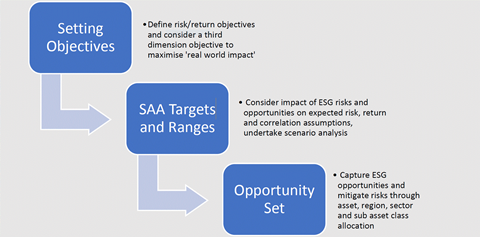Strategic asset allocation plays a fundamental role in determining long term returns and enabling asset owners to meet liabilities – in that sense the long term nature of issues such as climate change, demographics and resource depletion should make it an obvious place to start reviewing ESG themes and issues – exactly the type of issues that are covered in the Paris agreement and the UN’ sustainable development goals. These are the type of issues that are covered in PRI’s work on the Inevitable Policy Response – and it is challenges such as these that SAA need to start to incorporate and consider due to material impacts they may have on future returns.
Yet SAA is an area that has received relatively little coverage about what it should mean in practice. The publication of the PRI’s discussion paper on SAA reviews some of the options available to asset owners and asset managers.
Reviewing three steps within strategic asset allocation – setting of objectives, reviewing targets & ranges and identifying opportunities at an asset class level. Exploring the potential mechanisms through which ESG might be incorporated in each of these decision-making layers.
It also considers the possibility of including real world impact into this process with the question that if various asset mixes results in similar expected return – why wouldn’t asset owners select the asset mix to maximise positive real world impact.
This paper identifies a gap between asset owners’ aspirations regarding the integration of ESG factors, including climate change, and the SDGs, into investment processes and the way in which SAA and capital allocation decisions are made. The paper suggests some potential ways in which these pursuits could be brought closer into alignment. This process is still in early stages and we are hoping this will stimulate debate within signatories on this topic.
Background
This paper aims to highlight the links between an asset owner’s goals to incorporate ESG factors into investment policies and processes, and what this could mean for SAA frameworks. It includes a discussion on aligning ESG aspirations more broadly, and specifically in terms of climate change, as well as aligning them with the UN’s Sustainable Development Goals (SDGs), which are increasingly being incorporated into investment policies by much of the PRI’s signatory base.
The paper provides the basis for wider discussions and interactions across the PRI’s signatory base that the PRI intends to lead over the course of 2019/20, including: boards; chief investment officers and investment committees of asset owners; fiduciary managers; investment consultants, and multi asset managers. Following this outreach, the PRI intends to publish a guidance document in 2020 detailing key insights and actions, to support signatories in their efforts to embed ESG into SAA decision-making frameworks.
The key insights emerging from this exploration, thus far, suggest that current industry-wide practices do not sufficiently recognise the importance of ESG factors, including climate change and the SDGs, as part of the core SAA decision-making frameworks.

The paper sets out a number of opportunities to embed ESG into SAA frameworks that warrant further discussion, including:
Setting objectives
- This includes setting the primary risk/return objective, as well as considering an additional third dimension objective regarding the maximisation of positive ‘real world impact’.
Reviewing SAA targets and ranges
- This includes the impact of ESG risks and opportunities based on long-term capital market assumptions across asset classes, including undertaking scenario analysis that, in turn, impacts on SAA targets and ranges.
Reviewing the opportunity set
- Widening the potential investment universe to capture ESG opportunities and mitigate risks through asset, region, sector and sub-asset class allocation to assets that have unique ESG features or characteristics.
An illustrative example
- The PRI-supported Inevitable Policy Response to climate change programme of work is presented as an illustrative example of how SAA processes could be adapted in practice.
The discussion paper explores each of these areas in further detail. It is not, however, intended to act as a guidance document but rather to stimulate wider discussion on these topics on how PRI signatories might evolve SAA frameworks to more fully reflect their ESG aspirations going forward.







